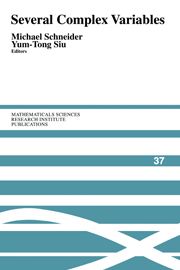Book contents
- Frontmatter
- Contents
- Preface
- Local Holomorphic Equivalence of Real Analytic Submanifolds in ℂN
- How to Use the Cycle Space in Complex Geometry
- Resolution of Singularities
- Global Regularity of the ∂-Neumann Problem: A Survey of the L2-Sobolev Theory
- Recent Developments in the Classification Theory of Compact Kahler Manifolds
- Remarks on Global Irregularity in the ∂-Neumann Problem
- Subelliptic Estimates and Finite Type
- Pseudoconvex-Concave Duality and Regularization of Currents
- Complex Dynamics in Higher Dimension
- Attractors in ℙ2
- Analytic Hilbert Quotients
- Varieties of Minimal Rational Tangents on Uniruled Projective Manifolds
- Recent Developments in Seiberg-Witten Theory and Complex Geometry
- Recent Techniques in Hyperbolicity Problems
- Rigidity Theorems in Kahler Geometry and Fundamental Groups of Varieties
- Nevanlinna Theory and Diophantine Approximation
Recent Developments in Seiberg-Witten Theory and Complex Geometry
Published online by Cambridge University Press: 25 June 2025
- Frontmatter
- Contents
- Preface
- Local Holomorphic Equivalence of Real Analytic Submanifolds in ℂN
- How to Use the Cycle Space in Complex Geometry
- Resolution of Singularities
- Global Regularity of the ∂-Neumann Problem: A Survey of the L2-Sobolev Theory
- Recent Developments in the Classification Theory of Compact Kahler Manifolds
- Remarks on Global Irregularity in the ∂-Neumann Problem
- Subelliptic Estimates and Finite Type
- Pseudoconvex-Concave Duality and Regularization of Currents
- Complex Dynamics in Higher Dimension
- Attractors in ℙ2
- Analytic Hilbert Quotients
- Varieties of Minimal Rational Tangents on Uniruled Projective Manifolds
- Recent Developments in Seiberg-Witten Theory and Complex Geometry
- Recent Techniques in Hyperbolicity Problems
- Rigidity Theorems in Kahler Geometry and Fundamental Groups of Varieties
- Nevanlinna Theory and Diophantine Approximation
Summary
In this article, written at the end of 1996, we survey some of the most important results in Seiberg-Witten Theory which are directly related to Algebraic or Kählerian Geometry. We begin with an introduction to abelian Seiberg-Witten Theory, with special emphasis on the generalized Seiberg-Witten invariants, which take also into account 1-homology classes of the base manifold. The more delicate case of manifolds with b+ = 1 is discussed in detail; we present our universal wall-crossing formula which shows that, crossing a wall in the parameter space, produces jumps of the invariants which are of a purely topological nature.
Next we introduce nonabelian Seiberg-Witten equations associated with very general compact Lie groups, and we describe in detail some of the properties of the moduli spaces of PU(2)-monopoles. The latter play an important role in our approach to prove Witten's conjecture. Then we specialize to the case where the base manifold is a Kahler surface, and we present the complex geometric interpretation of the corresponding moduli spaces of monopoles. This interpretation is another instance of a Kobayashi-Hitchin correspondence, which is based on the analysis of various types of vortex equations. Finally we explain our strategy for a proof of Witten's conjecture in an abstract setting, using the algebraic geometric "coupling principle" and "master spaces" to relate the relevant correlation functions.
Introduction
In October 1994, E. Witten revolutionized the theory of 4-manifolds by introducing the now famous Seiberg-Witten invariants [Witten 1994]. These invariants are defined by counting gauge equivalence classes of solutions of the Seiberg-Witten monopole equations, a system of nonlinear PDE's which describe the absolute minima of a Yang-Mills-Higgs type functional with an abelian gauge group.
Information
- Type
- Chapter
- Information
- Several Complex Variables , pp. 391 - 428Publisher: Cambridge University PressPrint publication year: 2000
